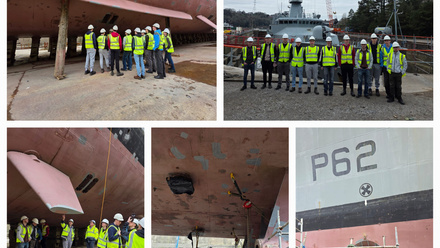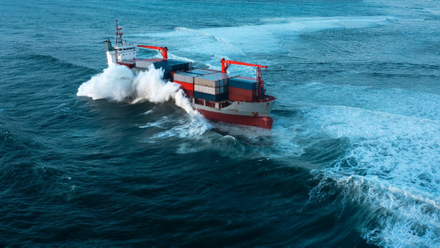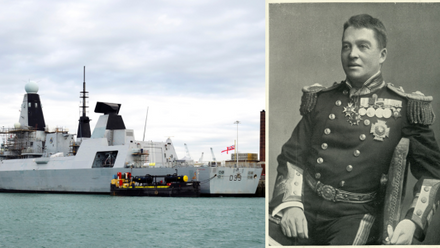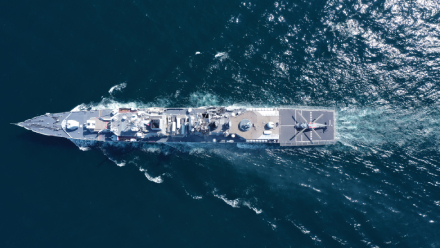A snapshot through time: Seven decades of the Royal Navy
The year 2022 saw both the 70th anniversary of the accession of Queen Elizabeth II to the throne, and her sad death. The years of her reign saw huge changes in all aspects of life, and the UK’s Royal Navy was not exempt.
In 1952, seven years after the end of World War II, the Royal Navy was vastly bigger than today but already experiencing change. It had been run down from its wartime strength but was still embroiled in the Korean War, which would last another year, and would be facing new threats. Many units were deployed in the conflict, but its strength was still impressive.
Facing down new challenges
At this time, the Navy was in transition. There were still battleships (one in service and four in reserve) but the emphasis was changing to aircraft carriers and the need for a whole new fleet of fast anti-submarine frigates to counter the Soviet threat.
The latter requirement was being met through the conversion of numerous World War II destroyers either partially as the Type 16s (10 conversions), or fully as the Type 15s (22 conversions), and with the plans to build two new dedicated classes, the six Type 12s and the dozen 14s. The Type 12 would become the model for many frigates to be built in subsequent years such as the Leanders.
In 1952, another requirement had been recognised – the need for a much-expanded minesweeping fleet. At the time the Royal Navy operated 25 Algerine class ocean minesweepers but lacked modern coastal units. Accordingly, it had 89 coastal and 61 inshore units on order or under construction.
The Royal Navy’s submarine fleet was also being updated with many existing units being modified with more streamlined hulls and conning towers and increased battery capacity to improve underwater speed.
Also under construction at the time were two experimental hydrogen peroxide-powered craft that would prove to be a dead end in seeking increased performance as nuclear power would shortly emerge as the better solution with the first example, the USS Nautilus, being completed just two years later.
As well as its many ships, the Royal Navy Fleet Air Arm provided an air component for operating from aircraft carriers as well as from shore. In 1952, it possessed a total of 3,700 aircraft and 56 naval air stations. Helicopters were also beginning to play an important part in the anti-submarine and transport roles and would, in years to come, be the sole aircraft aboard the carriers until the arrival of the Sea Harrier, just in time for the Falklands War.
Available to support the active fleet was the reserve fleet of nearly 400 ships of all types in various states of condition and readiness. However, the majority would never see service again as they were worn out after wartime operations.
The Coronation Review
A year after the accession, a Coronation Review of the fleet was held in June 1953 at Spithead, off the east coast of the Isle of Wight.
This involved 197 Royal Navy warships, together with 13 from the Commonwealth and 16 from foreign navies, as well as representative vessels from the British Merchant Navy and Fishing Fleets.
The Royal Navy in conflict
After the Korean War, the Royal Navy was involved in only a few major incidents including Suez in late 1956 but its biggest military campaign was the Falklands war of 1982.
Despite commitments to NATO and other deployments, it was still large enough to muster over the period of the conflict a force of some 100 vessels including two aircraft carriers, eight guided missile destroyers, 15 frigates, four submarines and two amphibious assault ships, plus numerous other vessels.
However, losses were substantial comprising two of the destroyers and two frigates with others suffering severe damaged.
The situation today
In 2023, the Royal Navy is much-reduced force – individual capabilities may be far superior to those of 70 years ago, but the numbers are few.
The fleet now comprises the following active units: Two aircraft carriers, six guided missile destroyers, 11 frigates, 10 nuclear-powered submarines (four ballistic missile submarines and six fleet submarines), nine mine countermeasures vessels, eight offshore patrol vessels, and two amphibious warfare vessels. In addition, there are a number of fast patrol boats and other smaller craft.
On order are two more nuclear fleet submarines, the first of the new Dreadnought class of ballistic submarines, and eight Type 26 and four Type 31 frigates. The latter will replace the 11 Type 23 frigates currently operational.
Royal Navy major active units:
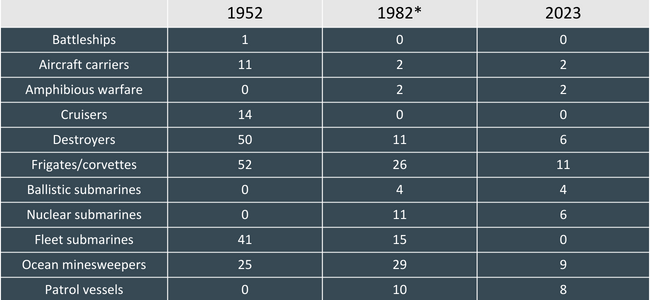
*Prior to Falklands War
Top image: HMS Trenchant was a Trafalgar-class nuclear-powered fleet submarine of the Royal Navy. It was decommissioned in 2022; Image credit: Shutterstock

